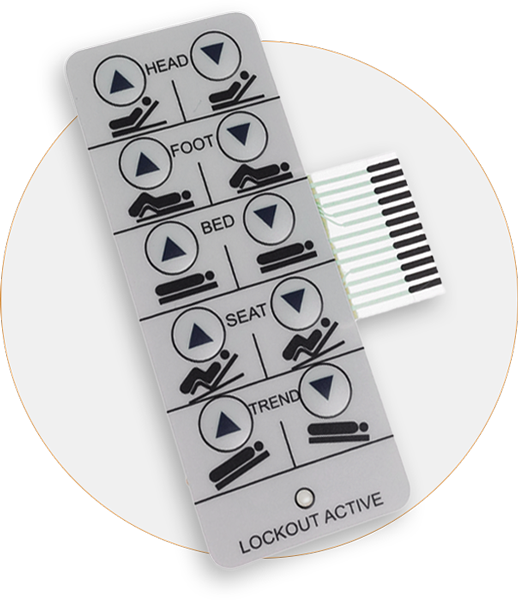The Complete Overview to Membrane Switch Innovation and Its Applications
The Complete Overview to Membrane Switch Innovation and Its Applications
Blog Article
How Membrane Changes Add To the Durability of Electronic Control Panels
Membrane layer buttons play a crucial role in boosting the sturdiness of digital control panels, largely with their multi-layered building which provides effective security versus ecological aspects such as dampness and dust. The absence of relocating components considerably lowers the possibility of mechanical failures, making membrane switches over suitable for requiring applications.
Definition of Membrane Layer Switches

Membrane buttons are created to be thin and lightweight, making them suitable for applications where room is limited. They can be produced in different shapes, dimensions, and shades, offering flexibility in design that meets aesthetic and functional needs. Additionally, membrane switches can incorporate various technologies, such as responsive feedback and LED signs, enhancing customer experience.
As a result of their building, membrane switches are commonly immune to dirt, dampness, and general wear, adding to their resilience sought after environments. Their smooth design not only promotes easy cleaning however also decreases the risk of mechanical failure, making them a favored selection for producers looking for dependable customer interfaces in their electronic control panels.
Defense Against Environmental Variables
The style of membrane switches inherently supplies a level of protection against numerous environmental factors, which is important for maintaining functionality in difficult problems - Membrane Switch. These switches are commonly constructed with layers of flexible products that shield inner components from wetness, dust, and impurities. By encapsulating the circuitry, membrane switches over decrease the risk of brief circuits and rust, which can dramatically hinder efficiency
Additionally, using durable adhesives and sealants during manufacturing improves their resistance to environmental difficulties. Membrane buttons can sustain direct exposure to chemicals and solvents, making them suitable for sectors such as food processing and healthcare, where hygiene and tidiness are paramount. Their seamless surface area design also prevents the buildup of dirt and germs, assisting in simpler cleaning and maintenance.
Temperature fluctuations are another environmental worry, and membrane switches are engineered to operate effectively throughout a large variety of temperatures (Membrane Switch). This flexibility ensures that control panels continue to be operational in various setups, from commercial atmospheres to consumer electronic devices
Influence On Individual Communication
Customer interaction with digital control board is substantially affected by the style and capability of membrane layer buttons. These buttons provide a responsive interface that enhances the overall customer experience, enabling user-friendly navigation and control. Their responsive nature makes sure that customers obtain instant comments upon activation, which is vital for tasks needing precision and efficiency.
In addition, the smooth surface of membrane layer switches helps with easy cleansing and maintenance, promoting user self-confidence in the reliability of the user interface. This tidiness is particularly important in environments where hygiene is extremely important, such as clinical or food handling setups. Furthermore, the compact and lightweight style of membrane changes adds to the visual charm of control panels, motivating user involvement through a modern-day and streamlined look.
Moreover, the integration of aesthetic elements, such as printed icons and backlighting, assists individuals rapidly determine features, minimizing the finding out curve associated with brand-new devices. As a result, customers can run gadgets more effectively, resulting in increased performance and complete satisfaction. In recap, membrane layer buttons play a critical duty in boosting user interaction by incorporating performance, appearances, and simplicity of usage, inevitably bring about enhanced operational efficiency.
Style Flexibility and Customization
Design flexibility and customization are necessary aspects of membrane switches, enabling suppliers to tailor digital control panels to details applications and individual requirements. This flexibility allows for the integration of different layout elements, such as colors, graphics, and textures, which can improve the aesthetic appeal and user his comment is here engagement of the control panel.
Membrane switches can be personalized in shapes and size, fitting a broad range of devices and applications, from commercial machinery to consumer electronic devices. This adaptability makes certain that producers can produce intuitive interfaces that align with individual expectations and functional demands. In addition, the capacity to incorporate one-of-a-kind attributes such as backlighting or responsive responses even more improves usability, permitting for a much more interactive experience.
In addition, the manufacturing procedure for membrane switches over sustains the fast prototyping of designs, making it possible for suppliers to repeat and fine-tune their principles quickly. This ability not just speeds up the growth timeline yet also makes certain that the end product fulfills specific practical and visual criteria.

Cost-Effectiveness and Long Life
Cost-effectiveness and durability are significant benefits of membrane switches, making them an appealing choice for suppliers and end-users alike. These switches are typically cheaper to produce than typical mechanical switches, largely as a result of their simplified production processes and the lowered number of components needed. This price advantage prolongs not only to first production yet additionally to long-term operational expenses, as membrane buttons commonly need much less maintenance and have a reduced failing rate.
Moreover, the longevity of membrane changes adds to their overall value. Click This Link Constructed from durable products, they are resistant to environmental factors such as moisture, dust, and chemicals, which can bring about early wear in other switch kinds. The lack of moving components lessens mechanical failing, permitting membrane changes to maintain functionality over expanded durations.
This longevity is particularly advantageous in applications needing regular efficiency under demanding problems, such as clinical tools and commercial devices. Ultimately, the combination of cost-effectiveness and longevity makes membrane layer switches over an economically practical selection for producers, giving reputable services that endure the test of time while enhancing monetary considerations.
Conclusion
In final thought, membrane switches dramatically enhance the resilience of electronic control panels through navigate to this site their robust building and protective functions - Membrane Switch. In general, membrane layer switches represent a dependable and economical selection for improving the longevity and functionality of digital control systems.
Report this page